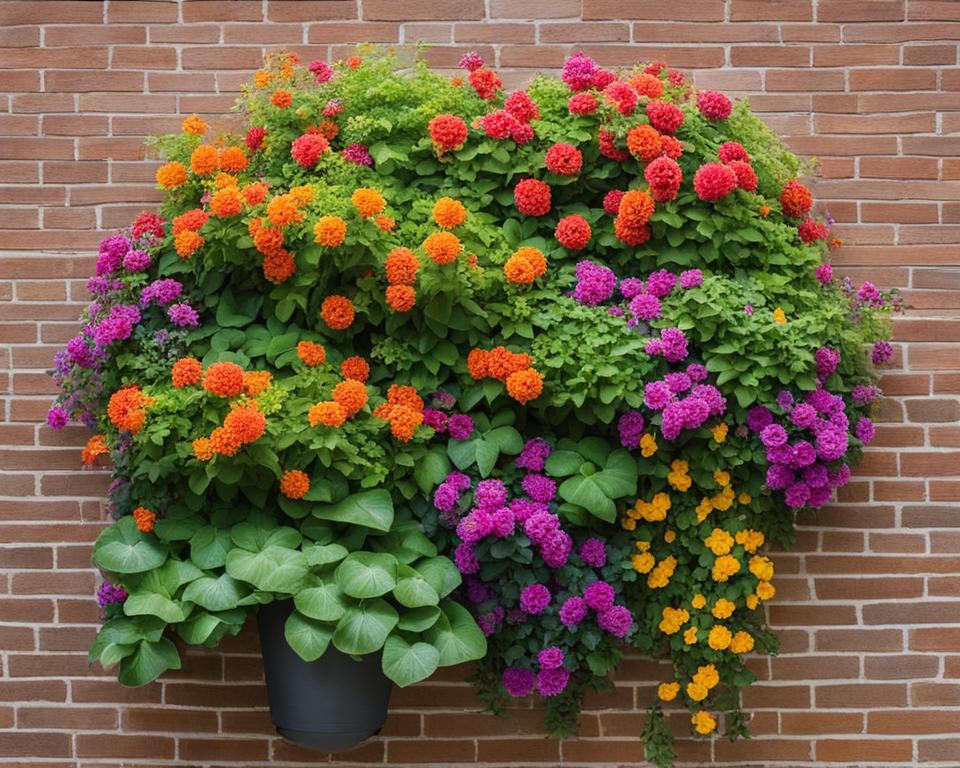As the season of rejuvenation ushers in, you might find yourself eyeing the dormant spaces within your urban domicile or compact backyard in Baton Rouge, contemplating the potential of a lush, blooming haven. Imagine transforming these areas into vibrant vertical tapestries of color and life through the innovative practice of vertical flower gardening. This method not only redefines the essence of small space flower gardening but also invites an artistic flourish to your outdoor or indoor environment. Think of a vertical flower bed as not only a solution to spatial limitations but as a testament to your creative spirit—a living, breathing work of art adorning your personal space.
Utilizing the verticality of your habitat maximizes square footage, bringing forth an element of nature’s majesty that is both easily accessible and splendidly diverse. Now is the opportune moment to embark on this verdant journey by elevating your floral displays skyward, etching a stroke of botanical brilliance against the Baton Rouge skyline.
Key Takeaways
- Embrace the burgeoning trend of vertical flower gardening for effective space utilization.
- Revitalize limited areas with lush vertical flower beds that ascend beyond traditional ground-level gardening.
- Discover innovative approaches and creative reinvention of vertical spaces, both indoors and outdoors.
- Enhance living spaces in Baton Rouge with biodiversity and natural beauty through vertical gardening.
- Adopt a practical yet aesthetically pleasing gardening technique tailored to the local climate.
- Gain an appreciation for the easy maintenance and organizational benefits of vertical flower arrangements.
Embracing Vertical Flower Gardening in Your Outdoor Spaces
Whether your goal is to maximize minimal space or simply elevate the aesthetic allure of your garden, vertical garden ideals are transforming outdoor areas across Baton Rouge. The concept of vertical flower gardening is an innovative and efficient use of vertical real estate, offering a beautiful solution that rises above traditional horizontal landscaping.
If you’re seeking resourceful and eye-catching approaches to create your floral oasis, then look no further! Here are a few vertical gardening tips to kick-start your journey:
- Begin with simple wall planters: these can be a dynamic first step towards a lush vertical landscape. They’re readily available and easy to install.
- Explore unique DIY projects: consider repurposing common household items such as old buckets, wooden pallets, or even soda bottles into planters.
- Select flora wisely: Couples plants that require similar care and share sunlight and watering needs to ensure your garden thrives.
- Ensure proper drainage: a critical aspect of any garden, especially when dealing with vertical installations, to prevent waterlogged roots.
- Think about long-term growth: opt for a vertical garden design that allows for plant growth over time, ensuring your space won’t become too crowded.
Implementing these practical and sustainable techniques will pave the way to creating your dream vertical flower garden. As you harness the sunlight and tailor your garden’s design to your unique specifications, you’ll discover the myriad possibilities of vertical gardening.
Embrace the blend of functionality and beauty with your vertical garden. It’s an invigorating way to connect with nature, adding an element of serenity and vibrant life to your Baton Rouge home. With a strategic design and a little creativity, you’ll soon cultivate a stunning display that ascends beyond your wildest gardening dreams.
The Benefits of Vertical Gardens for Flower Enthusiasts
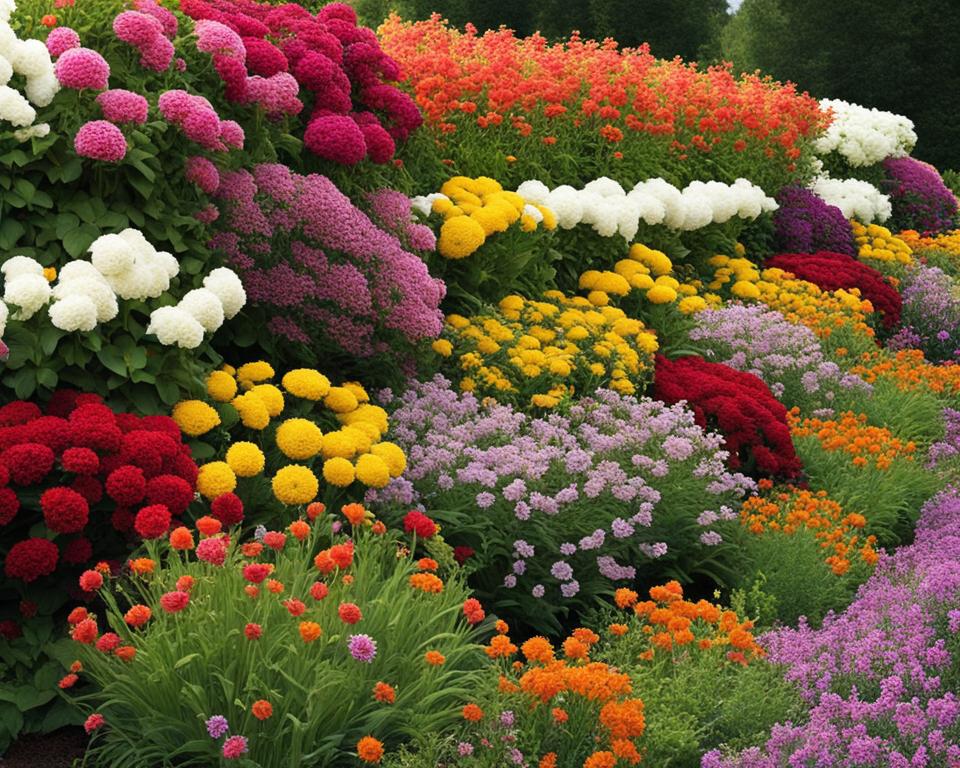
As cities grow and personal living spaces shrink, flower gardening enthusiasts are turning to innovative solutions to nurture their passion. That’s where the concept of vertical gardens comes in, offering a way to garden upwards rather than outwards. If you’re residing in a bustling urban area or simply grappling with the confines of a small backyard, vertical garden plants can provide a lush escape within the comfort of your own space.
Space Efficiency in Urban Gardening
For those who desire the joys of gardening but face the challenges of limited square footage, vertical gardens are the perfect compact solution. They maximize potential planting areas by expanding vertically, not only conserving space but also transforming underutilized walls or fences into vibrant focal points. Imagine your own vertical flower bed—a live tapestry of blooms that climbs skyward, offering both beauty and functionality to your small outdoor area or patio.
Aesthetic Appeal and Biodiversity
A vertical flower garden serves as more than just a practical response to spatial restrictions. It’s a canvas waiting to be painted with a diverse selection of plants that invite a myriad of textures, colors, and fragrances into your life. The result? A stunning visual display that enhances the aesthetic appeal of your urban dwelling while simultaneously promoting biodiversity.
Consider the following table, which outlines a few popular options for vertical garden plants and their contributions to a thriving and picturesque vertical flower bed.
| Plant Type | Attributes | Flowering Period |
|---|---|---|
| Ferns | Evergreen, air-purifying | N/A |
| Geraniums | Bright blooms, easy to maintain | Spring to Fall |
| Petunias | Vibrant colors, plentiful flowers | Spring to Winter |
| Succulents | Drought-resistant, varied forms | Varies by species |
| Ivy | Fast-growing, wall-covering | N/A |
As you delve into the diverse world of vertical gardening, remember that beneath its elegance lies the power to make a positive impact on the environment. By integrating a vertical flower bed into your gardening practices, you’re partaking in a sustainable movement, repurposing materials and fostering a greener planet—one plant at a time.
Starting Your Vertical Flower Garden: Choosing the Right Location
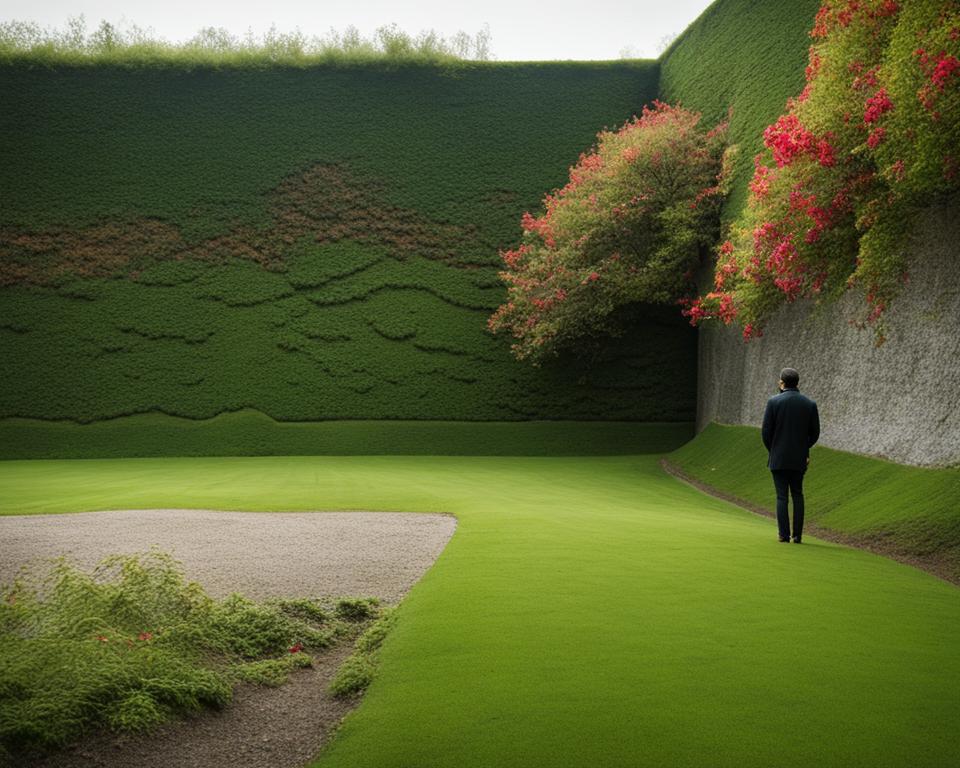
Initiating your journey in vertical flower gardening begins with the pivotal decision of choosing an optimal location. For Baton Rouge enthusiasts, this task is influenced not only by aesthetics but by practical considerations that will dictate the thriving potential of your blossoming walls. A cardinal point to start is ensuring your select spot garners enough sunlight; the essential life force that fuels plant growth. Six to eight hours of daily sun exposure is a benchmark for most flora, ensuring your vertical garden design doesn’t fall short on nature’s light.
As you ponder over the walls or rails to be adorned, it’s crucial to refine your choices based on the architecture available and exposure to elements. The perfect nook for your vertical garden containers is one that fosters growth, not hinders it. Here’s the essential visual to guide you through the process:
Consider the construction of living wall gardens, an exemplar of vertical greenery, which can metamorphose an ordinary wall or fence into an oasis. The right materials – whether wooden planters or felt-like fabric pockets – coupled with fitting plants, from succulents for dry conditions to lush ferns for shaded areas, are your building blocks to creating layers of green that transcend the usual.
Your geographical thumbprint, marked by Baton Rouge’s USDA Hardiness Zone, cannot be overlooked. It’s a lighthouse guiding your plant selection; ensuring that your venture into vertical flower gardening is one marked by beds of bloom rather than the wilt of poor planning. Factor in the microclimate of your locale, recognizing that different spots in your garden may offer varying conditions of shade, humidity, and wind.
- Review sun exposure and choose your site accordingly.
- Match garden placement with the appropriate plant palate for the climate.
- Embrace living walls as a core element of vertical garden design.
- Select vertical garden containers to complement both plants and space.
Afore embarking on this verdant voyage, leverage these insights to anchor your garden not just in place, but in potential. Let Baton Rouge’s climate bespeak the blooms of your vertical haven.
Vertical Flower Gardening: Inventive Design and Plant Selection
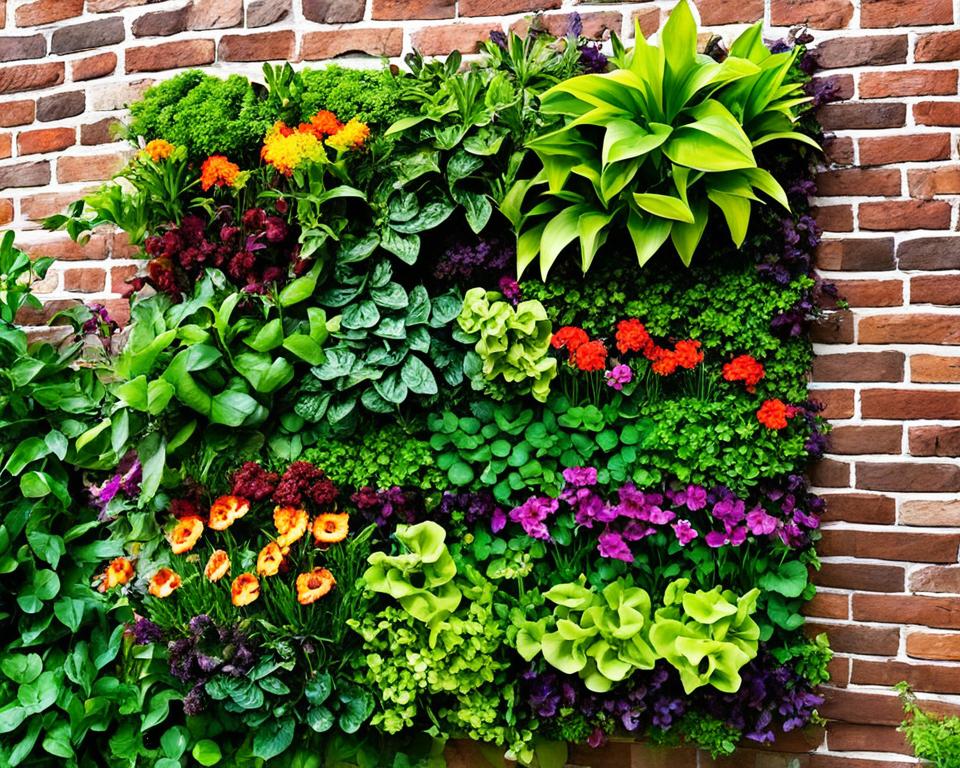
As you delve into the world of vertical flower gardening, the convergence of innovative design with the right choice of vertical garden plants shapes a garden that not only conserves space but invigorates your outdoor area with splendor. Mastering the art of vertical garden design takes both creativity and strategic planning, which can lead to a breathtaking and flourishing vertical garden capable of transforming even the humblest space into a vibrant botanical spectacle.
Creating Living Walls with Flowers
The concept of living walls introduces a canvas for botanical artistry right in the heart of Baton Rouge. These vibrant walls, whether composed of succulents or seasonal blooms, merge nature with modern design, offering a refreshing splash of color to urban landscapes. Materials like recycled wooden pallets or felt fabric pockets serve as eco-friendly foundations for your living walls, allowing you to vertically weave a tapestry of blooms that is not only eye-catching but also beneficial to the environment.
Utilizing Trellises for Climbing Varieties
Trellises offer a sturdy backbone for your vertical aspirations, providing indispensable support for climbing flora. Climbers like clematis, sweet peas, and climbing roses are perfect for adding vertical interest and a dash of romance to your garden space. Incorporating these structures into your vertical garden design is both functional and decorative, creating pieces of living architecture that elevate your outdoor space.
| Material | Plant Type | Design Function |
|---|---|---|
| Wooden Pallets | Small Flowers & Herbs | Eco-Friendly Wall Art |
| Fabric Pockets | Succulents & Ferns | Modern Aesthetic Appeal |
| Metal Trellises | Vine Plants & Climbing Roses | Support for Growth & Structure |
Maximizing Small Spaces with Vertical Garden Containers
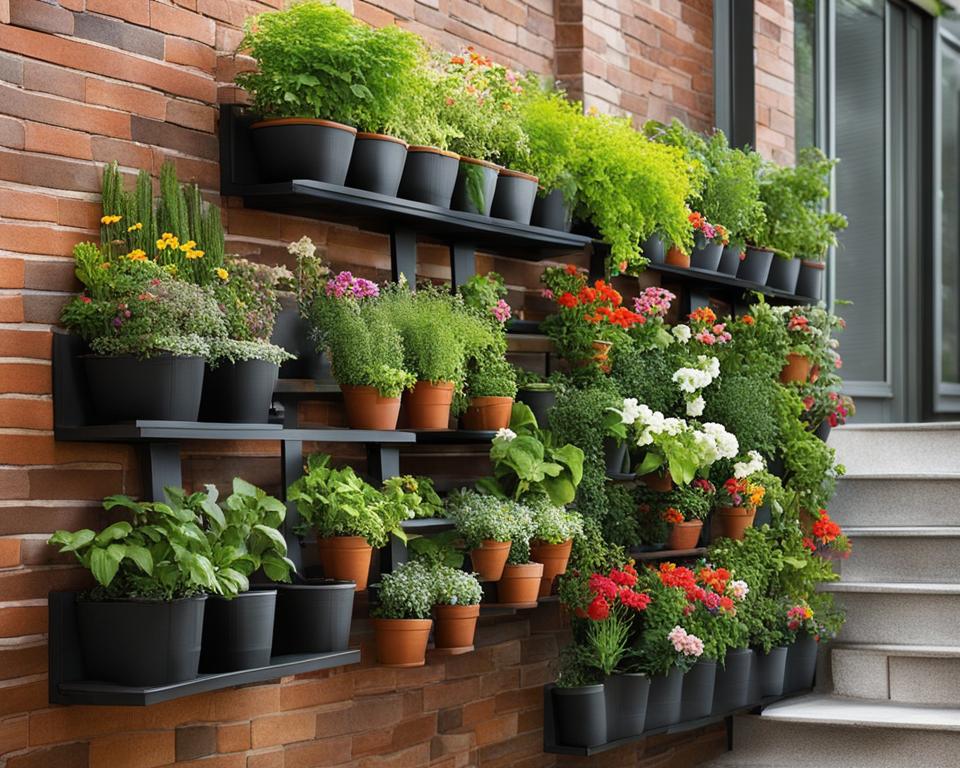
As urban living becomes increasingly dense, small space flower gardening emerges as a creative solution to cultivate lush landscapes in minimal areas. Leveraging the versatility of vertical garden containers, you can transform limited square footage into flourishing green retreats. Whether you’re nestled in the heart of Baton Rouge or a compact apartment elsewhere, these strategies allow you to enjoy the splendor of nature without the need for expansive ground plots.
Repurposing Household Items for Planters
Embrace sustainability while enhancing your living space by repurposing common household items as planters. Ingenious upcycling ideas not only save money but also contribute to eco-friendly gardening practices.
- Old gutters can become elongated planters perfect for adorning windows with draping blooms.
- Plastic bottles, with careful cutting and the addition of drainage holes, morph into unique hanging plant havens.
- Unused wooden crates or drawers can be given a second life as striking stand-alone vertical garden systems.
Choosing the Right Containers for Your Plants
Identifying the right type of container is essential for the success of your vertical flora. Factors such as material, size, and drainage need to be carefully considered.
| Container Type | Best Use | Material | Drainage |
|---|---|---|---|
| Fabric Pockets | Small Herbs & Flowers | Geotextile Fabric | Built-in |
| Recycled Bottles | Individual Plants | Plastic | Must be added |
| Wall Planters | Designated Garden Areas | Ceramic or Metal | Depends on design |
| Stackable Planters | Efficient Use of Vertical Space | Plastic or Terracotta | Usually incorporated |
Selecting containers that provide sufficient space for root expansion and boast adequate drainage will secure the vitality of your garden. From vibrant flowers to hearty greens, the right container choice supports a healthy ecosystem for your plants and elevates the aesthetic appeal of your small space flower gardening project.
Creating a Vertical Flower Bed: A Step-by-Step Guide
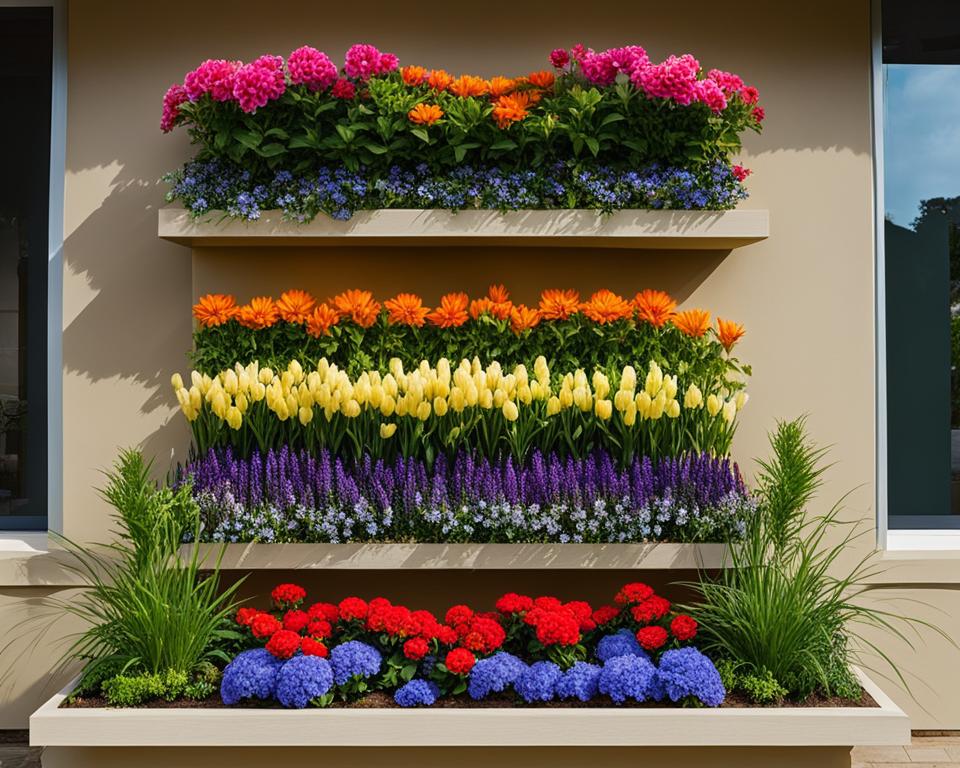
Embarking on the journey of vertical gardening can transform your outdoor spaces and enhance your gardening experience. If you’re considering designing a vertical flower bed, we’ve got a comprehensive guide to help you through the process. Whether you’re in Baton Rouge or beyond, these vertical gardening tips will ensure your garden thrives.
First, envisage your vertical garden design. Imagine how it will look against your balcony, patio, or yard. Then, choose the right materials and plants for your project. Here’s a breakdown of the key steps to set you on the right path:
- Select the Structure: Decide if you want to use a freestanding PVC tower or sturdy trellises. For smaller plants like herbs or strawberries, a PVC tower punctuated with holes for planting might be perfect. For larger, heavier plants, a trellis or wire grid offers excellent support.
- Prepare Your Materials: Gather your PVC or wood for the structure, potting soil, and the right species of plants that will thrive in a vertical setting.
- Consider Soil and Drainage: Ensure that your structure allows for proper drainage to prevent overwatering, which could be detrimental to plant health.
- Plant Selection: Choose plants that suit your climate, soil, and sunlight availability. Some plants require minimal soil, making them perfect for vertical growth.
A successful vertical flower bed starts with a solid plan and ends with the rewarding vision of your blossoming plants. By following these steps, planting with care, and regularly maintaining your vertical garden, you’ll enjoy a lush and productive green space that’s as beautiful as it is efficient.
Remember: The key to vertical gardening success lies in the joy it brings to you. Take your time selecting the plants that make you smile, and enjoy the process of bringing your vertical garden to life!
Vertical Garden Plants: Best Flowers and Foliage for Your Garden
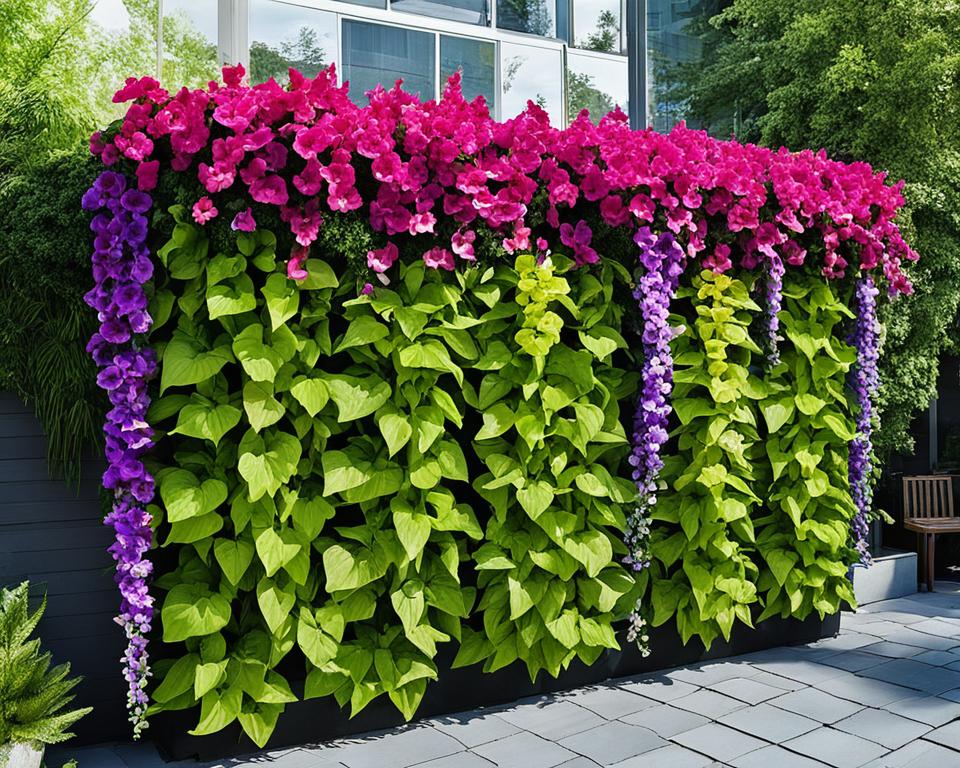
Creating a vibrant vertical flower garden starts with the selection of the right vertical garden plants. As someone exploring the realms of flower gardening, especially when interesting in vertical flower gardening, it’s essential you choose plants well-suited for vertical growth. Baton Rouge, with its unique climate, offers a myriad of options for both novice and experienced gardeners alike.
For a flourishing vertical display, consider incorporating annuals with bright blooms and compact root systems. Nasturtiums, petunias, and begonias are not only colorful but also adaptable to the vertical lifestyle. Moreover, vining vegetables such as cucumbers, cherry tomatoes, and pole beans not only add lush foliage but are also practical, providing fresh produce right from your wall!
Don’t overlook the charm that vining flowers bring to any space. Morning glories with their spirited trumpets and the fast-growing hummingbird vine, create a ballet of movement and color that’s both enchanting and aesthetically pleasing. Climbing roses are another favorite amongst gardeners for vertical flower gardens, given their ability to transform even the drabbest of fences into an alluring garden feature. Below is a list of ideal plant choices for your vertical garden:
- Nasturtiums – known for their bright, edible flowers.
- Petunias – offering a variety of vibrant colors.
- Begonias – admired for their prolific and lengthy blooming period.
- Cucumbers – perfect for a vertical vegetable garden.
- Cherry Tomatoes – small and ideal for vertical growth.
- Pole Beans – great for adding greenery and harvesting edible beans.
- Morning Glories – fast climbers with captivating flowers.
- Hummingbird Vine – a vigorous vine that attracts pollinators.
- Roses – the classics for adding elegance and fragrance.
When planning your garden, also consider the foliage which creates a lush backdrop and fills any gaps between blooms. Plants with a variety of textures and shades of green will add depth and contrast to your vertical flower gardening endeavors.
| Flower/Vine | Color Varieties | Blooming Season | Sunlight Needs |
|---|---|---|---|
| Nasturtiums | Yellow, Orange, Red | Spring to Fall | Full Sun to Partial Shade |
| Petunias | Wide range, including bicolors | Spring to Frost | Full Sun |
| Begonias | Red, Pink, White | Spring to Fall | Partial Shade |
| Morning Glories | Blue, Purple, Pink, White | Early Summer to Fall | Full Sun |
| Roses | Varies widely | Spring to Fall | Full Sun |
Remember, a successful vertical garden is a blend of form and function, so choose plants that will thrive in your specific environment and serve the purpose of your garden—be it for aesthetic enjoyment, a culinary harvest, or a habitat for wildlife. With the right plant selections, your vertical flower garden will become a living masterpiece in the heart of Baton Rouge.
Vertical Garden Systems: Integrating Technology in Gardening
Vertical garden systems are reshaping the landscape of urban horticulture, letting you dive into flower gardening with a technologically enhanced approach. When you integrate smart gardening solutions, such as automated irrigation and self-sufficient planters, you not only foster robust plant growth but also streamline garden maintenance—making these innovations an essential aspect of modern vertical gardening tips.
Imagine strolling through your Baton Rouge home garden, where the latest in vertical garden innovation takes the guesswork out of watering and plant care. These high-tech planters and systems are not futuristic dreams; they’re available today to make your vertical gardening experience more efficient and enjoyable.
- Composting Vertical Garden Planters: Convert organic waste directly into nutrients for your plants, reducing the need for external fertilizers.
- Enchanted Wall Planters with Self-Watering Capabilities: Stay worry-free about regular watering, thanks to these magical systems that ensure your flowers are hydrated and happy.
- Drip Irrigation Systems: Save water and time with precise drip systems that deliver the right amount of moisture straight to the roots of your plants.
Additionally, these systems come with multiple features designed to fit the unique requirements of your garden and lifestyle. Whether you’re a seasoned gardener or a newbie looking to enhance your green space, these innovative systems cater to all. Here’s a closer look:
| System | Features | Benefits |
|---|---|---|
| Smart Sensor Planters | Real-time soil moisture and light sensors | Optimizes plant care and prevents overwatering |
| Modular Vertical Structures | Expandable and customizable designs | Adapts to any space, allowing for creative garden layouts |
| Automated Grow Lights | Adjustable spectrums and timers | Simulates natural light conditions, promoting growth year-round |
With vertical garden technology, you’re not just planting flowers—you’re paving the way for a more resilient and sustainable future.
Take the leap and revolutionize your garden with vertical garden systems. Embrace the convenience, enjoy the beauty of your lush flower gardening endeavors, and thrive with the cutting-edge of horticulture in Baton Rouge and beyond.
Maintaining Your Vertical Garden: Tips and Tricks
As you delve into the world of vertical flower gardening, understanding the essentials of garden maintenance is key to ensuring your green space remains vibrant and flourishing. Successful vertical gardens hinge on two crucial practices: precise watering and diligent pruning. Embracing these practices will not only invigorate your plants but also enhance the overall design and appeal of your vertical garden.
Proper Watering Techniques for Vertical Arrangements
Adequate hydration is the lifeline of any garden, and vertical gardens are no exception. As these arrangements may dry out faster due to their exposure and drainage systems, implementing an efficient watering method is imperative. Drip irrigation and self-watering containers offer a consistent water supply, delivering it directly to the roots with minimal waste. Let’s explore how to best water your vertical garden for optimal health:
- Set up a drip irrigation system to provide a steady, targeted water supply to each plant.
- Invest in self-watering planters to keep soil consistently moist without the risk of overwatering.
- Check the moisture level frequently since vertical gardens may require more frequent watering.
Pruning and Care for Prolific Blooms
Meticulous care and regular pruning will yield a lush and robust vertical garden. By trimming overgrown foliage and deadheading spent blooms, you encourage new growth and maintain the pleasing aesthetics of your arrangement. Here are some vertical gardening tips to keep in mind for pruning your vertical flower garden:
- Regularly inspect your garden for dead or damaged foliage and remove them promptly.
- Train climbing plants to grow in the desired direction and attach them securely to their supports.
- Deadhead flowers to direct the plant’s energy towards producing more blooms.
Remember, Baton Rouge gardeners,
by following these foundational vertical gardening tips, your vertical garden can become not only a focal point of your home but a source of personal achievement in your gardening endeavors. Ensure you give your vertical flower garden the attention it deserves, and watch as it transforms into a living masterpiece.
DIY Vertical Garden Ideas: Personalizing Your Flower Garden
As a resident of Baton Rouge or any bustling area, you have the unique opportunity to transform your gardening space with DIY vertical garden ideas. These creative projects not only enhance your flower gardening experience but also add a splash of personality to your urban oasis. Let’s explore several ingenious ways to elevate your vertical garden design to new heights.
Whether you’re a seasoned gardener or a budding enthusiast, you can bring life to your vertical space by upcycling common household items into planters. Turn your balcony or patio into a lush, vertical retreat by repurposing wooden pallets into a vibrant flower display, or craft an elegant trellis from bamboo sticks for climbing roses and jasmine to create a fragrant living wall.
- Salvage old ladders as tiered plant stands for an eclectic mix of potted plants.
- Consider transforming plastic bottles into a fascinating hanging bottle garden that doubles as an eco-friendly statement.
- For a touch of rustic charm, repurpose an old wheelbarrow or a discarded dresser drawer into mobile planters that capture attention.
Involve family and friends in these eco-conscious projects to make flower gardening a shared, enjoyable journey. Not only will your unique vertical garden become a conversation starter, but it will also inspire others to explore sustainable gardening practices.
Here’s a quick guide to help you get started with your DIY vertical garden:
- Select a sunny spot that receives plenty of daylight for flourishing flowers.
- Gather all materials needed for your project, focusing on upcycled and repurposed items.
- Plan your design, considering the specific needs of the flowers you wish to grow.
- Assemble your vertical garden structure, securing it firmly in place.
- Fill it with quality soil and plant the flowers, then water accordingly to establish your plants.
- Enjoy the beauty and breathe in the fragrant scents of your handcrafted vertical flower garden!
Creating a DIY vertical garden is not only a way to exercise creativity but also acts as a step towards sustainable living. With a blend of imagination and practicality, you can own a piece of nature’s beauty even in a limited space. Embrace the art of vertical garden design, and watch your custom flower garden thrive.
Vertical Flower Gardening on a Budget: Cost-Effective Solutions
Engaging in vertical flower gardening doesn’t mean you have to splurge on supplies. With a bit of resourcefulness and creativity, you can convert your compact space into a blooming vertical oasis. Baton Rouge residents have the unique opportunity to merge the function of small space flower gardening with the aesthetic appeal of a lush green environment, all while maintaining a prudent budget.
Finding Affordable Materials and Plants
Starting your garden with cost-effective materials is easier than you might think. Look around your home for items that can be repurposed as vertical garden containers. Here are a few suggestions:
- Wooden pallets can be secured against a wall to house a variety of small pots or attached planters.
- Old shelves or drawers can be mounted vertically and filled with potting soil for an instant garden.
- Plastic bottles, when cut and hung, serve as excellent individual housing for herbs and small flowers.
Maximizing Plant Health with Low-Cost Resources
Ensuring your plants thrive doesn’t have to drain your finances. By employing inexpensive gardening hacks, you can promote lush growth without the hefty price tag:
- Composting kitchen scraps to create nutrient-rich soil amendments at no additional cost.
- Collecting rainwater in barrels or buckets to hydrate your plants and save on the water bill.
- Exchanging cuttings with fellow gardening enthusiasts to diversify your plant collection for free.
| Economical Resource | Benefits | Typical Usage |
|---|---|---|
| Compost | Rich in nutrients, stimulates plant growth. | Mix with soil for planting. |
| Rainwater | Free and natural water source. | Water plants as needed. |
| Plant Cuttings | Cost-free way to gain new plants. | Root in water or soil to propagate. |
Remember, your vertical flower gardening venture can be as affordable as it is rewarding. With these strategies, you’ll achieve a beautiful garden that’s both cost-effective and flourishing.
Conclusion
As we draw this article to a close, it’s evident that the scope of vertical flower gardening is as vast as it is rewarding. Baton Rouge and similar locales have already begun to witness the transformation that this innovative approach to horticulture can offer, especially in urban areas where space is at a premium. With vertical garden ideas aplenty and a slew of vertical gardening tips at your disposal, you can embark on a journey that not only enhances the visual appeal of your home but also contributes to eco-friendly practices and the enrichment of local biodiversity.
The Rewards of Vertical Flower Gardening
Embracing vertical flower gardening isn’t just about maximizing space; it’s about reaping the benefits of a lush, flowering oasis that hangs beautifully in your personal realm. The splendor of vertical gardens is not solely in their ability to turn a blank wall into a tapestry of blooms but also in their capacity to foster sustainable gardening habits. As you delve into this gardening method, you’ll discover the deep sense of personal satisfaction that comes with nurturing life in its vertical form. Your home in Baton Rouge can become a beacon of urban greenery, flourishing with the vibrancy of nature.
Fostering a Community of Vertical Gardeners
Moreover, the art of vertical flower gardening serves as a social catalyst, bringing together like-minded individuals keen on sharing their passion for gardening in the vertical dimension. This is not just about individual accomplishment; it’s about crafting a collective narrative—a community of vertical gardeners, eager to exchange knowledge, plants, and experiences. In unison, you can transform Baton Rouge into a model city for vertical gardens, illustrating how individuals can come together to escalate the beauty and functionality of their gardens skyward.
FAQ
What are the best plants for vertical flower gardening in small spaces?
For small spaces, choose plants with a climbing habit or those that tolerate living in containers, such as petunias, begonias, nasturtiums, and various vining vegetables and flowers like cucumbers, cherry tomatoes, morning glories, and roses. Always consider your local climate and sunlight availability when making your selection.
Can I create a vertical garden indoors?
Absolutely! Indoor vertical gardens can thrive with the right conditions. Use wall-mounted containers or modular systems, ensuring your plants receive sufficient light either through a sunny window or through artificial grow lights. Choose indoor-friendly plants such as ferns, succulents, and certain flowering houseplants that don’t need excessive sunlight.
How do I maintain a vertical flower garden?
Maintenance involves regular watering, which can be simplified with drip irrigation systems or self-watering planters. Prune and train your plants to manage growth, ensure air circulation, and encourage blooming. Also, periodically fertilize your garden and monitor for pests and diseases to keep your plants healthy.
What are some creative container ideas for a vertical flower garden?
Get creative by repurposing items such as wooden pallets, gutters, soda bottles, and buckets. These can be transformed into planters with a little modification for drainage and can be arranged in various patterns on walls or over structures to add a personalized touch to your vertical garden.
What are the best flowers for a vertical garden that need minimal maintenance?
Choose low-maintenance plants like sedum, portulaca, lavender, or ivy, which are drought-resistant and don’t require frequent pruning. These types of plants will provide color and texture to your garden without a lot of extra work.
How do I set up a watering system for my vertical garden?
A drip irrigation system is ideal for vertical gardens, as it delivers water directly to the base of each plant. You can set up a timer to automate watering, ensuring consistent moisture. For smaller setups or indoor gardens, a manual watering can with a long spout can be used to target each plant efficiently.
What should I consider when choosing a location for my vertical flower garden?
Look for a spot that gets 6-8 hours of sunlight daily if possible, as most flowering plants thrive in full sun. The location should also have access to water and be protected from strong winds that could damage your garden. If outdoors, check for any zoning restrictions or HOA guidelines in your area.
Are there cost-effective vertical garden systems available?
Yes, you can build your own vertical garden using affordable materials such as upcycled wood, fabric pockets, or recycled containers. Many gardeners use DIY methods to create vertical structures that are both functional and artistic without spending a lot of money.
How can I ensure my vertical garden is eco-friendly?
To create an eco-friendly vertical garden, opt for sustainable materials like reclaimed wood or recycled plastics for containers. Use organic soil and fertilizers, conserve water with a drip irrigation system, and choose native plants that are more likely to thrive in your local environment with fewer resources.
Can fruiting plants be grown in a vertical garden?
Definitely, many fruiting plants can be trained to grow vertically, such as strawberries, tomatoes, and even melons or pumpkins with the support of sturdy trellises. Just ensure they have enough soil depth, nutrients, and strong support to bear the weight of the fruit.
What are some tips for designing a visually appealing vertical garden?
To design an attractive vertical garden, vary the plant types, colors, and textures to create visual interest. Incorporate flowering plants for pops of color and evergreens for year-round greenery. Consider the overall design pattern of your plant placement and use containers that complement the style of the surrounding space.
How can vertical gardens help with biodiversity?
Vertical gardens can increase biodiversity by providing different habitats for a variety of plants, insects, and even birds within a limited space. They can also help to create microclimates that support diverse species and contribute to urban wildlife corridors.

